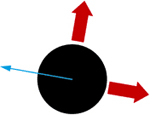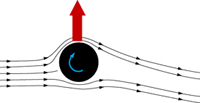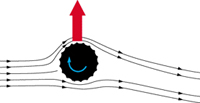| |
     


|
We Accept Check or Charge Cards
 |
|
 |
|
 |
|
|
|
 |
|
|
|
The Evolution of Golf Balls
Golf Ball
Evolution - Welcome to Your
Golf Headquarters
|
|
|
|
|
|
|

|
|
|
|
| |

 |
|
The
Aerodynamic Forces
on a Golf Ball
Simple Wing
Aligned with Airflow
|
Why
is There Air?
Given that golf is
the most technical sport, and scientists are the explorers of
technology, it was only a matter of time before the two got
together. From an aerodynamics standpoint, that didn't happen until
near the turn of the century, by which time golf was already
hundreds of years old. The science of aerodynamics, however, was
still young at that point. It should come as no surprise that the
momentous event occurred in Scotland, when physicist Peter Guthrie
Tait began publishing a series of scientific papers in 1890, which
were pioneering in their recognition that air had a lot to do with a
golf ball's amazing trajectory.
No doubt it is counterintuitive that the overall effect of air on
the flight of the golf ball is, in fact, very positive. After all,
wouldn't wind resistance slow the ball down and make it drop,
rocklike, to mother earth? Believe it or not, a shot that flies 230
yards in the normal atmosphere would only fly about 160 yards in a
vacuum. How can this be? Strangely enough, golf balls are brethren
to wings, and wings don't work if there's no air. By the magic of
aerodynamics, the spinning ball makes lift, suspending itself
against gravity. So it flies farther even though wind resistance (or
drag, as aerodynamicists call it) is slowing down. If the air were
to disappear, then the drag would disappear, but so would the lift.
The net result? You'd be pulling out the Big Stick for a middling
par 3 (assuming you could swing it while wearing a space suit).
|
| |
|
|
Simple Wing
at
Angle of Attack
|
Lift
and Drag
Every time we
stick a hand out the window at 65 mph (don't try this at home if you
live in a 55 state!), we're reminded that air exerts a force on any
object moving through it. Scientists like to break this force down
into two basic components: drag, which acts directly opposite the
motion to slow the object down; and lift, which acts at right angles
to the drag and generally upward. |
| |
|
|
Ball with No
Spin
Ball With
Backspin |
The
Origins of Lift
To the
uninitiated, watching a golf ball fly is an amazing experience. It
hangs in the air for an astonishing length of time, as if supported
by a force field. And it flies twice as far as a towering
second-deck home run. All of this goodness is possible because of
the aerodynamic lift force. But where does it come from?
While a person wouldn't confuse a golf ball with a 747 wing, a wind
tunnel might. To the air, they look very much the same. When a
simple wing is placed in an air stream and aligned with the flow
direction, it simply slices through the air with minimal hoopla, and
generates no lift. However, if it is inclined to create an angle of
attack, then interesting things start to happen. It deflects the
airflow downward, creating an upward reaction force (Newton's Third
Law: "To every action there is always opposed an equal reaction" -
which we know as the lift.)
A golf ball may look portly next to a streamlined wing, but it
manages to do similar things to the airflow. When a golf ball is
placed in an air stream, it pushes through the air creating a
considerable disturbance (that's the portly part), but generates no
lift. Here's the good part: given some backspin, it warps the
airflow very much like the angled wing, deflecting it downward and
creating lift. |
| |
|
|
Ball Punching
Through the Air
Dimpled Ball Punching
Through the Air
Golf Ball with
Spin and Dimples |
The Origins of Drag
Move any object through the air, and you'll get some drag. Most
flying bodies (not including the occasional golf club) have a
streamlined profile by design or by nature, so that they cut through
the air cleanly with minimal drag. But a golf ball has to be (guess
what . . . ) a ball, so it is destined to be an air punch rather
than an air knife. This makes for a large drag force.
The air hits the front of the ball, creating a high pressure area,
and splits around to the sides. But like a teenager in a Camaro,
it's going too fast to make the turn to the back of the ball. It
separates from the surface, leaving a low pressure wake like the one
a boat leaves in the water. This combination of high pressure on the
front of the ball with low pressure on the back is the main source
of a ball's drag.
This may seem hopeless, but it's not. Maybe you can't control the
teenager, but you can put better tires on his or her car. The
solution? Dimples. When the surface of the ball is covered with
dimples, a thin layer of air next to the ball (aerodynamicists call
it the boundary layer) becomes turbulent. Rather than flowing in
smooth, continuous layers (a laminar boundary layer), it has a
microscopic pattern of fluctuations and randomized flow. Here's the
good part: a turbulent boundary layer has better tires. It can
better follow the curvature of the ball's profile. It travels
farther around the ball before separating, which creates a much
smaller wake, and much less drag. In fact, a dimpled golf ball has
only about half the drag of a smooth one. |
| |
|
|
Wind Tunnel Smoke Flow
(Picture F.N.M. Brown) |
Putting it all Together
If we combine the spinning motion, which warps the airflow and
creates the lift, with the dimples, which reduce the wake and cut
the drag, we get the flow pattern around a golf ball.
Proof, you say? Professor F. N. M. Brown of the University of Notre
Dame was famous for his work in visualizing flow patterns by
injecting streams of smoke into a wind tunnel.
To the left is one of his pictures of an actual spinning dimpled
ball. While the spin rate he used appears to have been quite low by
golf ball standards, you can still see the warpage of the flow
field, especially in the angle at which the wake trails away from
the back of the ball.
|
|
| |
|
|
|
|
|
|
|
|


|
|
|
 >
>
![]()












